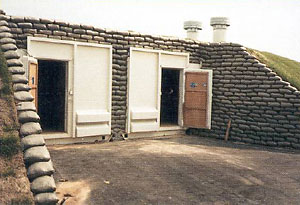What's in This Document
Please note that our explosives storage webpages have been recently reorganized and renamed.
 |
Storage Requirements
The Federal explosives regulations at 27 CFR, Part 555, Subpart K, provide specific requirements for explosives storage magazines. This webpage is intended to provide information that may be useful to Federal explosives licensees and permittees.
Pursuant to 27 CFR § 555.205, all explosive materials must be kept in locked magazines that meet the standards in 27 CFR, Part 555, Subpart K – Storage, unless they are:
- In the process of manufacture;
- Being physically handled in the operating process of a licensee or user;
- Being used; or
- Being transported to a place of storage or use by licensee or permittee or by a person who has lawfully acquired explosive materials under 27 CFR § 555.106.
Explosive materials that are not subject to the above conditions and are not otherwise exempt pursuant to 27 CFR § 555.141 and 27 CFR § 555.32, must be stored in accordance with all prescribed storage requirements in 27 CFR, Part 555, Subpart K – Storage.

